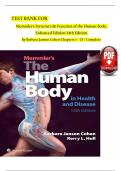TEST BANK FOR
Memmler's Structure & Function of the Human Body,
Enhanced Edition 14th Edition
By Barbara Janson Cohen Chapters 1 - 25 / Complete
, TABLE OF CONTENTS
Chapter 1 Organization of the Human Body
Chapter 2 Chemistry, Matter, and Life
Chapter 3 Cells and Their Functions
Chapter 4 Tissues, Glands, and Membranes
Chapter 5 Disease and Disease-Producing Organisms
Chapter 6 The Integumentary System
Chapter 7 The Skeletal System
Chapter 8 The Muscular System
Chapter 9 The Nervous System: The Spinal Cord and Spinal Nerves
Chapter 10 The Nervous System: The Brain and Cranial Nerves
Chapter 11 The Sensory System
Chapter 12 The Endocrine System: Glands and Hormones
Chapter 13 The Blood
Chapter 14 The Heart and Heart Disease
Chapter 15 Blood Vessels and Blood Circulation
Chapter 16 The Lymphatic System and Lymphatic Circulation
Chapter 17 Immunity
Chapter 18 The Respiratory System
Chapter 19 The Digestive System
Chapter 20 Metabolism, Nutrition, and Body Temperature
Chapter 21 The Urinary System
Chapter 22 Body Fluids
Chapter 23 The Male and Female Reproductive Systems
Chapter 24 Development and Birth
Chapter 25 Heredity and Hereditary Diseases
,Chapter 01: Introduction to the Body
MULTIPLE CHOICE
1. The word derived from two word parts that mean ―cutting apart‖ is
a. physiology
b. homeostasis
c. anatomy
d. dissection
ANSWER: C DIF: Memorization REF: p. 3
OBJ: 1 TOP: Introduction
2. The study of how the body functions is called
a. physiology
b. homeostasis
c. anatomy
d. dissection
ANSWER: A DIF: Memorization REF: p. 3
OBJ: 1 TOP: Introduction
3. The correct sequence of the level of organization is
a. cellular, chemical, tissue, organ
b. chemical, cellular, tissue, organ
c. chemical, cellular, organ, tissue
d. chemical, tissue, cellular, organ
ANSWER: B DIF: Memorization REF: p. 5
OBJ: 3 TOP: Structural levels of organization
4. The smallest living unit of structure is considered to be at the
a. chemical level
b. cellular level
c. organ level
, d. tissue level
ANSWER: B DIF: Memorization REF: p. 6
OBJ: 3 TOP: Structural levels of organization
5. The reference position for all body directional terms is the
a. anatomical position
b. prone position
c. supine position
d. sitting position
ANSWER: A DIF: Memorization REF: pp. 6-7
OBJ: 4 TOP: Anatomical position
6. The relationship between the knee and the ankle can be described as
a. the knee is inferior to the ankle
b. the knee is distal to the ankle




